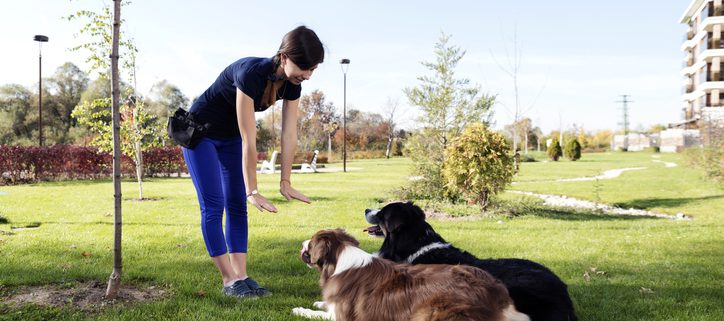How to Establish Leadership Over a Dog, Without Being a Meanie Pants
If your dog does not perform a simple sit-stay, there could be an underlying issue that isn’t being addressed.
When the role of the leader is not determined or is inadvertently handed over to the dog, it could be the cause behind many behavior problems that the dog is having or difficultly experienced during training.
Before any behavioral adjustment or successful training can be expected, you need to establish leadership over the dog in order to set the dog up for success.
However, recent studies have found that dogs tend to avoid confrontation and communicate with one another primarily through body language. When a dog owner acts as leader of the pack, he or she demonstrates non-confrontational behaviors while acting confident, dependable and very consistent.
Establish Leadership Over the Dog
Dog owners who need to implement leadership exercises in the relationship with their dog may find themselves frustrated with how their dog relates to them.
Common behaviors that dogs exhibit when they are in need of this type of restructuring:
- Pushiness at the front door
- Require that they not be touched while sleeping
- Bark at anything they want for as long as they please
- Demand-bark or -scratch
- Defend or guard any food items or possessions they want
- Ignore known commands
While canines may exhibit these types of annoying behaviors, many owners do not realize that they are reinforcing how their pets act.
Some common things owners do that enforce the mindset that the dog is in charge:
- Allowing the dog to be on beds and furniture
- Offering an overflowing food bowl
- Giving unearned possessions (toys, bones and treats)
- Giving unearned or demanded attention and petting
If these are behaviors that you see in your dog, you can easily change the pecking order within your “pack” without touching your dog or acting aggressively. Below are three ways to establish leadership over a dog in a way your pet can understand.
- “No Free Lunch” Policy
This policy allows the dog to receive things that he likes (attention, treats, petting) only after complying with a known, simple obedience cue. Some people use obedience commands only when the dog is about to or already has done something wrong. They offer everything the dog enjoys for “free.”
I suggest incorporating this “No Free Lunch” policy into your daily activities by requiring that the dog listen and obey before he receives enjoyable things; you become the leader.
- Controlled Meals
Dogs should not be fed an overflowing food bowl that is always available at any period in their lifetime (unless they are lactating). Otherwise, you not only allow them to be in charge of the food, but you increase the chance of an overweight, unhealthy dog.
Dogs older than 6 months can be fed twice daily. To find out how much your dog should be eating, look at the label on the back of the dog food bag.
When demonstrating leadership during a meal time, ask the dog to sit, and hold the food bowl over his head. When he does sit, say “Good!” and slowly lower the bowl. If the dog gets up, give a “no reward marker” like “Eh-eh” or “Nope,” and quickly raise the bowl up again.
By staying consistent with this practice, you will teach him that if he wants to eat, he must remain calm and obedient. As the dog improves on this behavior, introduce a release cue like “Okay!” before he is allowed to eat his food. Also, the dog must finish his food in one sitting. If he leaves the food, pick it up until the next scheduled feeding time.
- Doorway Management
Something as simple as who goes through the doorway first could show the dog who is the leader of the household.
If your dog crowds you at the door, make an imaginary line about 5 inches before the threshold of the door. With the door closed, ask your dog for a sit-stay and say “Good” when he complies. Slowly open the door and watch to see if he gets up. If he starts to get up, quickly shut the door and give a “no reward marker.” Continue to do this until you have the door fully open as the dog waits for a release cue like “Okay!”
When consistent with this exercise, you can show your dog that you control the doorway and his freedom. This exercise also highly reduces the chance of your dog bolting out of the doorway, which increases his safety.
When implementing the above exercises, you can also assist the restructuring by acting like a leader.
Established leaders always:
- Stay calm and in control
- Eat first
- Assume higher ground (beds, couches, chairs)
- Do not offer free attention or treats
- Assign resting spots for their pack mates (your dog)
- Set the pace and direction when walking
When living with a dog, you must establish calmly and assertively who is the leader and maintain your status. If the dog is not clearly shown who is in charge, he may assume he is the leader, which could become chaotic quickly. All relationship exercises should be worked on simultaneously for best results.



